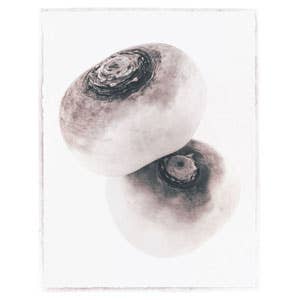
Enduring
If you don’t boil it into oblivion or hurl it at a passing outcast, the humble, dependable turnip may surprise you with its sweet warmth and nourishing soul.
I know no other vegetable as long-suffering as the turnip, none that has so patiently endured a lifetime of disdain. Its grubby façade and pungent, mustardy aroma may put some people off, and it can, frankly, be bitter and unappealing when overcooked or eaten out of season. But I think it's time for the turnip, one of the oldest cultivated vegetables around, to be treated with a little respect. When it is enticingly caramelized beneath a sizzling lamb roast, whipped up into a gutsy puree to accompany crisp pork sausages, or transformed by beef stock, cream, and egg yolks from its Cinderella-like origins into a truffly and seductive soup, its true worth is irrefutable.
As I was born in England when wrinkly turnips were still being boiled to death and beaten into watery, insipid mash, it has occurred to me to ponder why I feel such affection for this unprepossessing root. On a culinary level, I have my mother to thank: she learned how to handle turnips from her grandmother, a careful cook of earthy stews, who knew how to temper the bitterness and coax the goodness out of the weekly tuppence worth she bought to enhance the cheap, rationed cuts of meat in postwar London. So it was that their flavor came to sweeten my childhood while the lingering effect of their misuse soured that of others. Indeed, most of my English friends still shun the turnip, its name alone inducing a shuddering recollection of the sulfurous smells of boarding-school dining rooms. My mother, in turn, credits my fascination with the turnip to my "early romantic stage", when I returned her copy of Thomas Hardy's Tess of the d'Urbervilles wilted and pummeled like my young sense of justice; a particularly bleak image was to remain with me of the heroine laboring in the wintry turnip fields, throwing the vegetables into the slicer to be shredded for fodder. It was too late to save Tess from her miserable fate, but why should it be so for the downtrodden turnip?
Believed to have originated in northern Europe some 4,000 years ago, the turnip was swiftly relegated to the kitchens of the poor as a mundane staple. The Aryans, during their rule of India, beginning circa 1500 B.C., went so far as to pass a law specifying that the lowly turnip should never soil the lips of the noble classes. By the Middle Ages turnips had become so commonplace in Europe that they were hurled at outcasts; in Britain, they were cultivated primarily for livestock.
The Romans confused the turnip with other roots, including the radish and the beet. In fact, it is a member of the mustard green family, a cool-season bunch that includes cabbage, cauliflower, and brussels sprouts. Brassica rapa is the botanical name for our common, round white turnip with its purple stain—which can also be oblong or flattened, in shades of pink and yellow—and for the French navet in all its forms, plump or carrot shaped, as well as numerous other varieties (the rutabaga, or swede, is a related species). The navet, especially in its petite, springtime guise, is perhaps the most irresistible of all.
Not surprisingly, then, the French have historically had a great affinity for turnips, employing them in many dishes—like canard aux navets (duck braised with whole, glazed baby turnips). The British, on the other hand, have only recently been celebrating the vegetable's renaissance, no doubt spurred by a new emphasis on seasonal produce and a proliferation of farmers' markets in the United Kingdom. Indeed, across continents, the Anglo-Saxon perception of the turnip as a dreary workhorse, moldering at the back of the fridge, is slowly shifting. And inspiration is hardly lacking. In the Middle East and Asia, turnips have been pickled for centuries; in China they are also sun-dried and preserved in soy sauce; and in India they might be first tenderized in sour yogurt and then sauteed in the vibrant company of tomatoes, cayenne, and cumin.
I must be careful lest my evangelical fervor get the better of me, as my husband—a boarding-school victim—wearily attested when I cried out recently, for the five hundredth time, "Oh, I do wish you liked turnips!" But he has kept an open mind, even conceding that we include them in the spring lamb stew we served at our wedding in France, into which they were thrown to greedily drink up the lamb juices. And do you know what? My joy may just have been topped that day as I walked between the tables to observe, with secret glee, that not one of our guests had been able to resist them.
Keep Reading
Continue to Next Story










